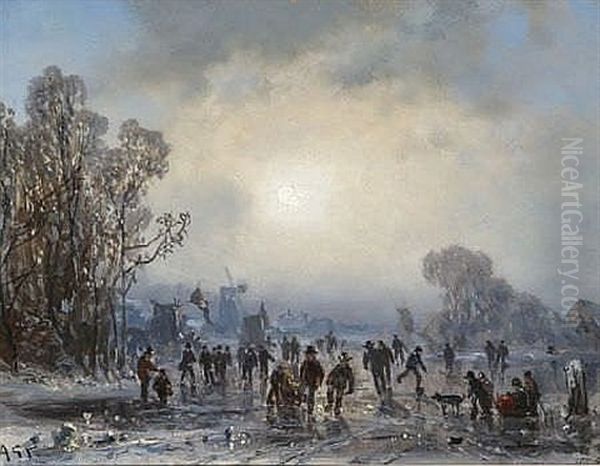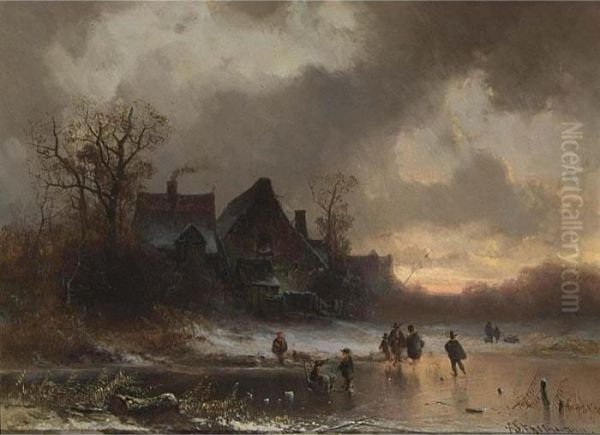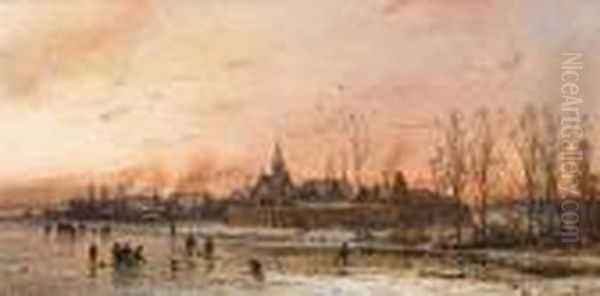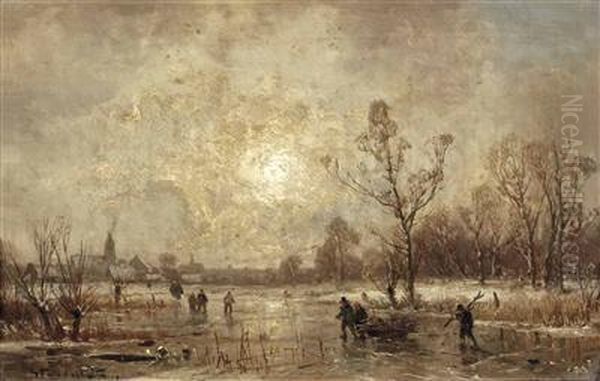Adolf Stademann (1824-1895) stands as a notable figure within the rich tapestry of 19th-century German art. A native of Munich, the city that would remain central to his life and career, Stademann dedicated himself to landscape painting. While his oeuvre encompassed various natural scenes, he carved a particular niche for himself as a master interpreter of winter, capturing the unique atmosphere, light, and human interactions associated with the season in Germany. His work, executed primarily in oils, reflects the prevailing Realist tendencies of his time, combined with a deep appreciation for the traditions of landscape painting, particularly those of the Dutch Golden Age.
Munich: An Epicenter of 19th-Century German Art
To understand Adolf Stademann's artistic journey, one must appreciate the environment in which he worked. Munich, during the 19th century, especially under the patronage of King Ludwig I, burgeoned into a major European art center, often rivaling Paris and Vienna. The Royal Academy of Fine Arts attracted talent from across Germany and beyond, fostering a vibrant atmosphere of learning, competition, and stylistic development. This era saw the rise of the Munich School, a term broadly encompassing the various styles flourishing there, but often associated with a painterly realism, influenced by Dutch and Flemish masters, and a focus on genre scenes and landscapes. Artists flocked to the city, drawn by its institutions, exhibition opportunities, and the picturesque Bavarian landscape nearby.
Early Life and Artistic Formation
Born in Munich in 1824, Adolf Stademann entered a world where art was gaining increasing prominence. While specific details about his formal artistic education remain somewhat scarce in readily available records, it is highly probable that he received training either at the Munich Academy or through private study with established masters, a common practice at the time. His development occurred within the city's dynamic artistic milieu.

An important factor in his background was his family connection to the arts. His father, August Ferdinand Stademann (1800-1856), was himself an artist and architect, known particularly for his work on large-scale panoramas. These immersive paintings were a popular form of entertainment and visual education in the 19th century. August Ferdinand collaborated on or was associated with significant works like the Athens Panorama, sometimes linked also with the prominent Munich landscape painter Carl Rottmann. This familial immersion in artistic creation likely provided Adolf with early exposure and encouragement towards his own path as a painter.
Artistic Style: Realism Tempered by Atmosphere
Adolf Stademann's style is firmly rooted in the Realist tradition that gained traction in the mid-19th century, moving away from the heightened emotion and symbolism of Romanticism, exemplified by artists like Caspar David Friedrich. Stademann focused on the observable world, rendering landscapes with a commitment to accuracy in form, detail, and the effects of light. His brushwork, while descriptive, often retained a certain painterly quality characteristic of the Munich School.
A significant influence on Stademann, as with many Munich artists, was the legacy of the Dutch Golden Age painters of the 17th century. He clearly admired their mastery of light, atmosphere, and detailed rendering of landscape and daily life. One can see echoes of artists like Hendrick Avercamp, famous for his lively winter scenes crowded with skaters, or Aert van der Neer, renowned for his moonlit and winter landscapes, in Stademann's thematic choices and his attention to atmospheric effects. The way he captured the low light of winter days, the reflections on ice, or the texture of snow suggests a careful study of these predecessors.
While primarily a Realist, some aspects of his work hint at an awareness of emerging trends, possibly the atmospheric concerns that would lead towards Impressionism. His sensitivity to light and shadow, and his depiction of everyday moments within the landscape, align with the broader European shift towards capturing transient effects and scenes of contemporary life, a path explored more fully in France by artists like Claude Monet or Camille Pissarro, and in Germany through figures associated with the Barbizon School's influence, such as Stademann's contemporary and fellow Munich resident, Adolf Heinrich Lier.
The Enduring Fascination with Winter
Stademann's reputation is inextricably linked to his winter landscapes. This thematic focus distinguishes him within the broader field of German landscape painting. Painting winter presents unique challenges: capturing the subtle gradations of white in snow, the reflective qualities of ice, the bare structures of trees, and the distinct, often cold, quality of winter light. Stademann met these challenges with considerable skill.

His winter scenes are rarely empty vistas. They are often populated with figures engaged in typical winter activities: people skating or playing on frozen rivers and ponds, woodcutters working in the snow-covered forests (Winter Field), or villagers going about their daily lives against a backdrop of frost and ice. These figures add life and narrative interest to the scenes, grounding the potentially stark beauty of winter in human experience. His paintings evoke a range of moods, from the cheerful bustle of communal fun on the ice (Winter Fun on the Ice) to the quiet solitude of a snow-muffled forest path. He masterfully conveyed the crisp air, the low-hanging sun casting long shadows, and the sense of stillness that often accompanies a snow-covered world.
Representative Works: A Glimpse into Stademann's World
Several titles recur in records of Stademann's work, offering insight into his typical subjects and style:
_Winter Fun on the Ice_ (also known as _Winter on the Ice_ or _Winterliches Eisvergnügen_): This subject appears multiple times, suggesting its popularity. These works typically depict expansive frozen waterways bustling with figures skating, socializing, or playing games like ice stock sport (Eisstockschießen), common in Bavaria. Stademann excelled at capturing the lively atmosphere, the varied postures of the figures, and the interplay of light on the icy surface. These paintings celebrate the communal aspect of winter recreation.
_Winter Field_ (_Winterliches Feld_): Often featuring figures like woodcutters or farmers, these works focus on rural labor during the harsh season. They might depict solitary figures against a vast snowy expanse or small groups working near cottages or forest edges. The mood can be one of quiet perseverance or the stark beauty of the working landscape in winter.
_Night Scene, Farmers and Livestock by the Lake_ (_Nächtliche Szene, Bauern und Vieh am See_): Nocturnes presented a particular challenge, requiring skill in rendering low light, moonlight, or artificial light sources. This title suggests a scene focused on atmosphere, perhaps contrasting the dark silhouettes of figures and animals against moonlit water or snow. It connects Stademann to a tradition of nocturnal landscapes explored by artists like Aert van der Neer.
_Winter Landscape_ (_Winterlandschaft_): As a more general title, this likely encompasses a variety of Stademann's winter scenes, perhaps focusing purely on the natural landscape – snow-covered hills, frozen streams, bare trees under a winter sky – showcasing his ability to capture the essence of the season even without significant human presence.
These works, typically executed in oil on canvas or panel, vary in size but often maintain dimensions suitable for private collection, contributing to their circulation on the art market over the years.
Travels and Sketching: The Dutch Album of 1870

Evidence of Stademann's travels and working methods comes from a fascinating document: a sketchbook titled Album dating from 1870. This album chronicles a journey through the Netherlands, a region whose artistic heritage clearly resonated with him. It contains numerous illustrations – sketches and more finished drawings, some bichromatic – capturing the landscapes and local life encountered along a route from the Maas River to cities like Rotterdam, Delft, and Papendrecht.
The sketchbook is more than just a collection of visual impressions. It includes personal notes, written in French, detailing visits to museums, specifically mentioning artworks observed in the Musée de Bruxelles. This indicates Stademann's active engagement with the art of the past, using his travels not just for landscape motifs but also for study. The album even contained ephemera like greeting cards, adding a personal touch. This artifact provides valuable insight into his process: observing, sketching on location, and studying the masters, all feeding into his studio practice in Munich.
Teaching, Influence, and Connections
While perhaps not running a large, formal workshop, Stademann did contribute to the education of younger artists. Notably, Karl Heffner (1849-1925), who later gained recognition for his atmospheric landscapes, particularly of English scenes, studied with both Stademann and Adolf Heinrich Lier in Munich. Heffner's sensitive handling of light and mood may owe something to the guidance he received from these established landscape painters.
Stademann also appears to have influenced Anton Doll (1826-1887), a contemporary Munich painter also known for his charming winter scenes and townscapes, often reminiscent of Dutch 17th-century art. Doll's stylistic affinities with Stademann, particularly in their shared interest in detailed, atmospheric winter settings inspired by Dutch prototypes, suggest a mutual awareness and likely influence.
His connection, likely through his father August Ferdinand, to the circle around Carl Rottmann (1797-1850), a major figure in Munich landscape painting known for his heroic cycles of Italian and Greek landscapes, places the Stademann family within the mainstream of Munich's artistic developments. Although Adolf's style differed significantly from Rottmann's monumental classicism, the connection underscores the interconnectedness of the city's art scene.
Stademann worked alongside other prominent Munich landscape painters who focused on the local Bavarian scenery, such as Eduard Schleich the Elder (1812-1874) and Josef Wenglein (1845-1919), contributing to a collective visual identity for the region's landscape art, characterized by realism and atmospheric sensitivity.
Market Recognition and Lasting Legacy

Adolf Stademann's works have consistently appeared on the art market, indicating sustained interest from collectors. Auction records from various houses, including European auctioneers like Sopocki Dom Aukcyjny in Poland, show his paintings being offered and sold regularly. Prices vary depending on size, subject matter, condition, and provenance, but generally fall within a range accessible to collectors of 19th-century European art, often from several hundred to several thousand Euros.
Works like Winter Fun on the Ice, Winter Field, and various Winter Landscapes achieve respectable prices, confirming their appeal. The estimates and sale prices (e.g., €532 for a Dutch-themed landscape, €800-€1200 for typical winter scenes, €1500-€2000 for larger or more complex compositions like the Night Scene) reflect a solid market position for a skilled representative of the Munich School, even if he doesn't command the prices of the era's biggest names like Wilhelm Leibl or international figures.
His legacy lies in his dedicated and skillful portrayal of a specific theme – the German winter landscape. He captured not just the visual appearance but also the feeling of the season, from its harshness to its moments of communal joy. He stands as a significant contributor to the Munich School's landscape tradition, admired for his technical proficiency, his atmospheric sensitivity, and his consistent focus on the beauty and character of his native Bavarian environment, particularly under its winter mantle. While perhaps less innovative than some contemporaries, his work offers a valuable and enduring window onto 19th-century German landscape painting and the enduring appeal of winter scenes. His paintings continue to be appreciated for their charm, detail, and evocative power. Other German landscape artists of the broader period whose work provides context include Andreas Achenbach and Hans Thoma.
Conclusion: An Enduring Eye for Winter's Charm
Adolf Stademann remains a respected figure in German art history, primarily celebrated for his mastery of the winter landscape. Working within the vibrant context of 19th-century Munich, he absorbed the influences of Dutch masters and the prevailing Realist ethos, developing a distinctive style characterized by detailed observation, atmospheric sensitivity, and a focus on human activity within the natural world. His depictions of skaters on frozen rivers, woodcutters in snowy forests, and moonlit winter nights continue to resonate with viewers and collectors. Though perhaps overshadowed by artists with broader thematic ranges or more revolutionary styles, Stademann's dedicated exploration of winter's multifaceted character secures his place as a significant and enduring painter of the Munich School. His work serves as a testament to the quiet beauty and lively spirit that can be found even in the coldest season.